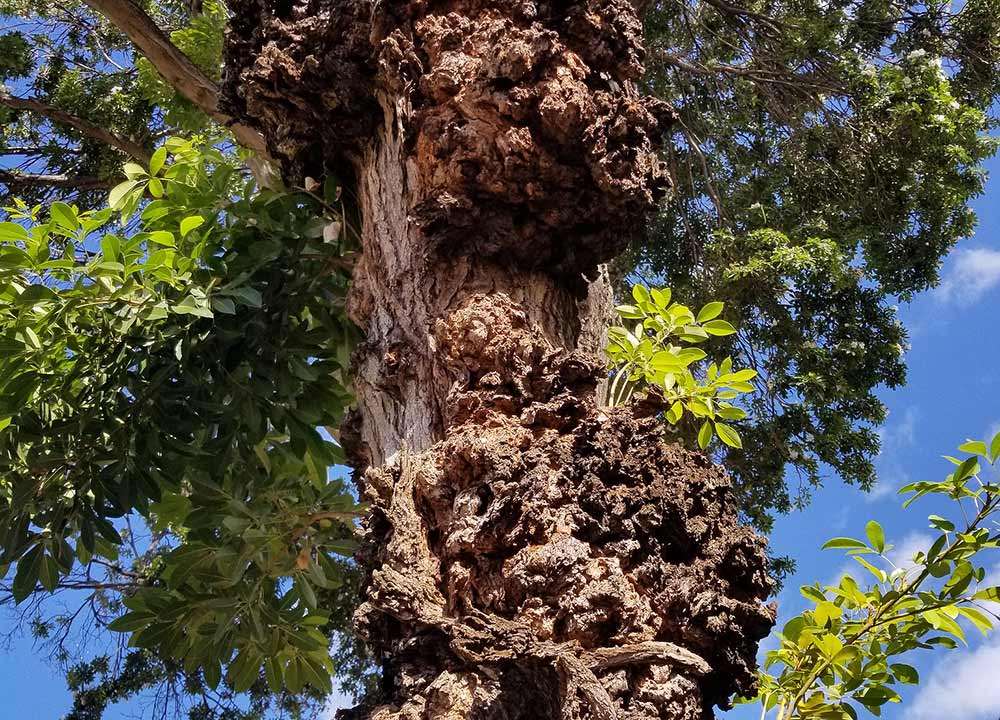By Dr. Thomas T. Yamashita
Crown gall is caused by the bacterium Agrobacterium tumefaciens. The bacterium is drawn to wounds to which it attaches and transfers its circular DNA into the walnut tree genome. Characteristics encoded by the DNA include:
- The production of copious amounts of amorphous, undifferentiated, cancerous cells which accumulate and agglomerate to form the galls representative of crown gall.
- The production of unusually high levels of auxin, which partially accounts for the cell division and cell enlargement.
- The production of unique forms of proteins, the opines, which serve to minimize competition and promote reproduction of the bacteria.
The unique means by which Agrobacterium tumefaciens infects its hosts—through injection of a circular DNA derived from the pathogen—has prompted many researchers to utilize A. tumefaciens in genetic engineering research as a vehicle for transferring gene sequences to various plants.

Agrobacterium tumefaciens is vulnerable in competitive environments, but can cause serious injury to vulnerable walnut seedlings.
A. tumefaciens is not a good competitor in the soil. In fact, it’s not a strong competitor in any environment, especially in the presence of competitive, antagonistic beneficial species. Thus, specific microbial activation of the soil environment can place enough pressure on the pathogen to keep it under control.
The problem arises during planting of bare-root seedlings which have multiple wounds, paving the way for isolated infections. Recall that once the genetic material of the bacterium is transferred to the host cell, all subsequent cells derived from this single infected cell are then encoded to become amorphous, undifferentiated, cancerous cells.
This causes damage to infected walnut trees in a number of ways:
- There is disruption of vascular flow.
- The soundness of the root system is damaged by interstitial galling. Galling near the crown limits the number of new roots, and injures the root beyond the interstitial gall. The root tissue distal to the gall is weakened to the extent that attrition and death beyond the gall becomes imminent.
- Perhaps the most devastating aspect of crown gall is the extreme susceptibility of the undifferentiated, corky, amorphous and cancerous tissues to secondary infection by opportunistic pathogens, as well as otherwise beneficial microbial species, such as wood-rotting fungi.
- The profusion of phytotoxins permeating throughout the tree cannot help but limit both the functionality and physical volume of roots and rootlets.
The use of popular hormonal treatments can exacerbate the potential for crown gall disease.
When planting bare root walnut seedlings, it is very important that the grower sees to it that the lateral roots are thinned for spatial distribution. Because walnut roots expand at a rapid rate and enlarge both in girth and length, lack of thinning contributes to the girdling and/or splitting of the crown tissues, leaving the tree vulnerable to secondary infections that generally result in such a severe infection that severe debilitation or death typically follows.
In the last 15 years or so, there has been a surge in the use of plant hormone products. In numerous cases I have witnessed the deleterious effects of the treatments, many of which are used to increase the number of roots developing off the crown. The problem is that this produces unnaturally dense root growth, causing girdling and splitting of the crown tissues, which opens the door to infection.
Crown gall infection can be prevented simply by thinning seedling roots prior to planting.
There is a reason why walnut trees have such a small number of lateral roots. Tree species with large numbers of these high density lateral roots have died out because such trees develop open wounds from the previously described scenarios. Thus, always limit the number of lateral roots so as to avoid girdling and pushing against one another leading to splitting of the crown.
To properly prepare roots for pruning and thinning, wash the roots free of dirt and debris. Then, dip bare roots with wounds or cuts into a live suspension of Agrobacterium radiobacter, a bacterium which produces an antibiotic that is exceptionally effective in killing to the pathogen. Following this methodology will significantly reduce the likelihood of newly planted walnut tree seedlings developing crown gall.




